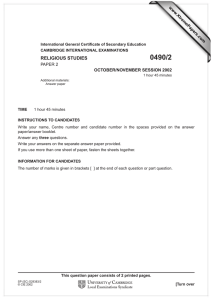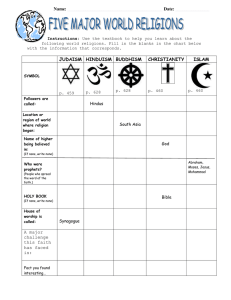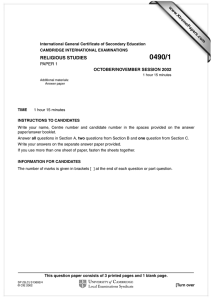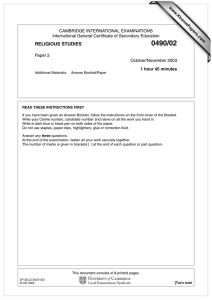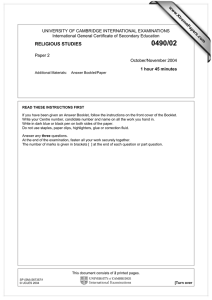www.XtremePapers.com
advertisement
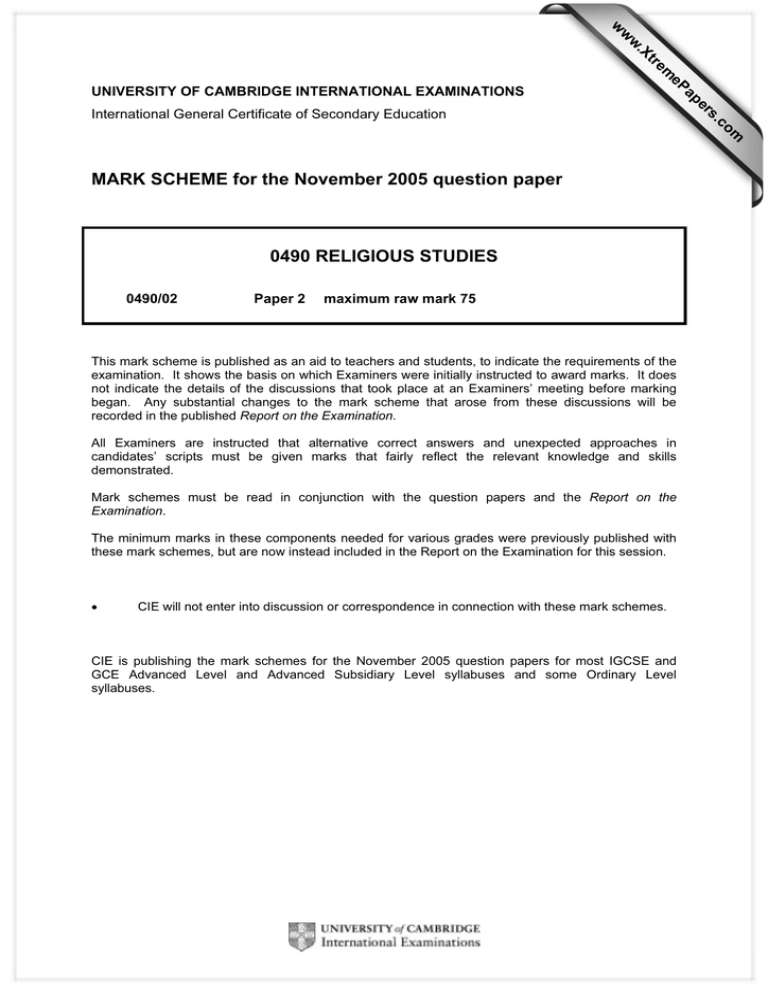
w w ap eP m e tr .X w UNIVERSITY OF CAMBRIDGE INTERNATIONAL EXAMINATIONS 0490 RELIGIOUS STUDIES 0490/02 Paper 2 maximum raw mark 75 This mark scheme is published as an aid to teachers and students, to indicate the requirements of the examination. It shows the basis on which Examiners were initially instructed to award marks. It does not indicate the details of the discussions that took place at an Examiners’ meeting before marking began. Any substantial changes to the mark scheme that arose from these discussions will be recorded in the published Report on the Examination. All Examiners are instructed that alternative correct answers and unexpected approaches in candidates’ scripts must be given marks that fairly reflect the relevant knowledge and skills demonstrated. Mark schemes must be read in conjunction with the question papers and the Report on the Examination. The minimum marks in these components needed for various grades were previously published with these mark schemes, but are now instead included in the Report on the Examination for this session. • CIE will not enter into discussion or correspondence in connection with these mark schemes. CIE is publishing the mark schemes for the November 2005 question papers for most IGCSE and GCE Advanced Level and Advanced Subsidiary Level syllabuses and some Ordinary Level syllabuses. om .c MARK SCHEME for the November 2005 question paper s er International General Certificate of Secondary Education Page 1 Mark Scheme IGCSE – November 2005 Syllabus Paper 0490 2 Marking Criteria Marks should be awarded according to the following Levels of Response for each Assessment Objective. All Questions part (a) Assessment Objective A [10 marks] Total marks Level 1 Level 2 Level 3 Level 4 10 1-3 4-6 7-8 9-10 Assessment Objective A: Knowledge Level 1, mark range 1-3: some attempt to deal with the task. The inclusion of a small amount of relevant information. Limited ability to organise work or present an argument. Level 2, mark range 4-6: a basic attempt to deal with task. Some of the relevant information will have been selected with evidence of organisation. Level 3, mark range 7-8: a reasonable attempt to deal with the task. Salient information selected, organised and presented with some skill. Level 4, mark range 9-10: an excellent attempt to respond to the task in an individual way. The work will be presented in a clear, coherent manner. All Questions part (b) Assessment Objective B [15 marks] Total marks Level 1 Level 2 Level 3 Level 4 15 1-4 5-8 9-12 13-15 Assessment Objective B: Understanding and Interpretation Level 1, mark range 1-4: limited understanding of religious language and concepts, with facts often presented as understanding. There will be few explanations offered. Limited ability to recognise the relationship between an issue and the study of religion. Level 2, mark range 5-8: some understanding of religious language and concepts although lacking in depth. Some ability to recognise the relationship between religious belief and practice. The ability to make simple comparisons and recognise similarities and differences. Level 3, mark range 9-12: a wider, more mature level of understanding of religious language and concepts. The ability to recognise the relationship between © University of Cambridge International Examinations 2005 Page 2 Mark Scheme IGCSE – November 2005 Syllabus Paper 0490 2 religious beliefs and practice. The ability to recognise and handle religious issues. Level 4, mark range 13-15: the demonstration of a thorough understanding of religious language and concepts. Clear explanations of the relationship between religious beliefs and practice. Confidence in the recognition and handling of religious issues. Answer all parts of any three of the questions. In each case, a maximum of half the marks (in proportion to the Level achieved) is available for each of the two religions when explicitly required in each part-question. However the balance of material within complete answers should be assessed holistically according to the relative amount and complexity of the information/understanding implicit in the subject-matter for the relevant religion, and some questions do not explicitly require discrete approaches for each religion. 1 ‘Going through a religious ceremony when you are born makes no difference to the rest of your life.’ (a) Describe the birth ceremonies of two of Christianity, Islam and Judaism. Maximum Level 1 for merely naming two appropriate ceremonies (1 mark for just one). Christianity: Baptism/Christening takes place some time after the birth. The essential element of baptism is the pouring over/immersion in water and the saying of the Trinitarian formula baptizing the child. Not all Protestant denominations practise infant baptism and in this case a dedication ceremony of some sort is carried out. Description of a baptism will vary according to the denomination chosen, but the lighting of candles is likely to figure and the naming aspect of the ceremony should be mentioned. Islam: the first words a Muslim baby hears are the Adhan (call to prayer) whispered into the right ear. Some parents may also say the ’Iqamah (call to rise and worship) into the left ear. The words are usually said by the oldest male present. Other customs might be observed but these are more cultural than religious. Seven days after the birth there is a second ceremony: aqiqa when the father announces the baby’s name to the friends and relatives, and prayers are said for the baby’s future health. The baby’s head is wiped with olive oil and then washed or shaved. The equivalent weight of the shaven hair, in gold or silver, is given to the poor of the community. Names are very significant in Islam and are chosen with care. Either one of these can be credited up to full marks according to the Levels – there is no requirement for both. Judaism: Brit Milah – circumcision – takes place on the eighth day after a boy is born, following the command given to Abraham by G-d (in Genesis 17:9-12). It is a sign of the covenant between G-d and his people. The ceremony usually happens at home and various people are involved and prayers are said before the baby is circumcised by the © University of Cambridge International Examinations 2005 [10] Page 3 Mark Scheme IGCSE – November 2005 Syllabus Paper 0490 2 mohel. Then the mohel says a blessing over a cup of wine, announces the boy’s name, and gives him a small drop of wine. For girls, a blessing (simchat habat) is offered in the synagogue the Sabbath after her birth. Some candidates may mention the Pidyon Haben, redemption of the firstborn male, which may be credited. (b) Explain the importance which followers of these two religions attach to their birth ceremonies. [15] In each case expect, and give credit for, further/repeated description of the ceremonies chosen as an integral part of explaining their importance to followers of the religion. In each case, the ceremony performs two essential functions: the child is welcomed into membership of the religious community and his/her name is given (in Islam the two ceremonies are seven days apart). An understanding of the importance of formal induction into the religion should be shown for L4. 2 ‘Funerals are for the people who are still alive, not for those who are dead.’ (a) What are the main funeral practices in two of Christianity, Islam and Judaism? Christianity: Christian funeral rites are very diverse according to denomination and tradition, so credit descriptions given from candidates’ personal experience. Some or all of these may be included: procession into church, wearing black, readings from the Bible, a talk about the person and his/her life, an expression of confidence in the resurrection, singing hymns and/or psalms, prayers for the dead person, requiem mass for Roman Catholics, burial or cremation afterwards. Islam: again there are variations in Muslim funeral practices according to local traditions and customs, but essentially the body is buried as soon as possible after death. The corpse is washed, wrapped in a shroud and placed in a coffin. The body is carried to the cemetery by a procession of male Muslims, and the body (where this is permitted by law) is placed in direct contact with the earth, protected by planks of wood or the inverted coffin. The head is orientated towards Makkah. Prayers are said by the grave, including the Al-Fatihah (Surah 1) and prayers for forgiveness for all. Judaism: when someone dies, Jews say Kaddish, a prayer praising G-d associated with funerals and mourning. The dead person is buried as soon as possible, on the day of death or the day after. The body is washed and wrapped in a shroud and, for a man, a tallit with the fringes cut off. The body is placed in a plain wooden coffin and never left alone until the burial. The mourners make a tear in their clothes before the burial to show their grief, and the funeral service is short and simple. The body is buried (though some progressive communities permit cremation). Afterwards is a period of mourning, and the family will sit Shiva for seven days, saying the Kaddish three times a day, keeping a candle burning, © University of Cambridge International Examinations 2005 [10] Page 4 Mark Scheme IGCSE – November 2005 Syllabus Paper 0490 2 covering the mirrors, not shaving or cutting their hair, and sitting on low stools. Description of Shiva is not required for a full L4 as it is not strictly a funeral practice. (b) Explain what these two religions teach about the after-life. [15] Christianity: full answers will cover the existence of the soul, judgement and the disposition to heaven or hell (possibly mentioning purgatory). Resurrection of the body (according to Paul’s teaching) may be mentioned and should get credit. Similarly, some may not understand the implications of Justification by Faith, and may assert that the soul will be judged according to works as suggested by the parable of the Sheep and the Goats, and, on that authority, can get Level 4. Speculation about becoming angels, playing harps, meeting St Peter etc. should not gain much credit. Islam: actions will be judged by Allah on the day of judgement at the end of the world. Until then the dead are kept in barzakh, a sort of limbo outside time, by Azra’il, the angel of death. At death, two angels of justice visit the person and record their good and bad deeds. At the Day of Judgement there will be a bodily resurrection, and those whose good deeds outweigh the bad will go to Paradise; the wicked will be sent to Hell. There are graphic descriptions of Paradise and Jahannam in the Qur’an but these are generally considered to be symbolic of an existence beyond human imagining. Judaism: Jewish teaching is unclear so credit can be given to answers that make this statement. Judaism does not have any specific teaching about life after death. Resurrection is mentioned in the book of Daniel, and ideas about judgement, heaven and hell are comparatively recent – the judgement will take place after the coming of the Messiah. 3 ‘Festivals are really an excuse for a party, not a religious event.’ (a) Describe the celebration of a festival in two of Christianity, Islam and Judaism. There is a wide variety of possible festivals that might be chosen, some of greater significance and with more to describe than others – flexible marking according to Levels is required. Candidates who mistakenly choose non-festive special days (e.g. Good Friday, Ramadan, Yom Kippur) should get credit for accurate description up to the maximum for Level 3. Christianity: Christmas, Epiphany, Easter, Whitsun/Pentecost, Saints’ Days Islam: Id-ul-Fitr (end of Ramadan), Id-ul-Adha (three-day festival of sacrifice during Hajj) – possibly Salat-ul-Jumu‘ah (Friday prayers) Judaism: Pesach/Passover, Shavuot/Pentecost, Sukkot, Simchat Torah, Purim, Hannukah Rosh © University of Cambridge International Examinations 2005 Hashanah, [10] Page 5 (b) Mark Scheme IGCSE – November 2005 Syllabus Paper 0490 2 Explain why festivals are a very important part of religious life for many people in these two religions. [15] Answers may either try to explain the importance of each of the two chosen festivals, in which case, expect and credit some repetition of material from (a), or candidates may write more generalised answers about the importance of festivals in religious life – reminding people of the events celebrated, giving an opportunity for a holiday and relaxation both at home and in the religious community, giving a shape to the progress of the year. 4 ‘People need to be together to worship, you cannot do it on your own.’ (a) Describe private and public worship in two of Christianity, Islam and Judaism. Description of the buildings in which public worship takes place is not really appropriate as an exclusive approach to this question, but is likely to be part of a full answer. Christianity: There is a wide variety of possibilities in Christianity according to the denomination/service known about/chosen. Private worship might include Bible study, prayer, saying the Rosary, meditation; public worship includes Mass/Eucharist/Lord’s Supper celebrated in a variety of ways, Mattins/Evensong in the Anglican Church, Pentecostal worship with speaking in tongues and healing, preaching/Bible-based services. Islam: private worship includes du‘a – personal prayer at the end of salat – and the use of prayer beads for keeping count when saying the 99 names of Allah. Public worship takes place at the mosque and a full description will include wudu’ beforehand, facing Makkah (indicated by the mihrab), saying the takbir and al-Fatihah, and performing cycles of rak‘ah making up the appropriate salat for the time of day. Individual Muslims will, if possible, carry out these prayers at the appropriate time of day (indicated by the calls from the mosque by the muezzin) wherever they happen to be, but praying together in the mosque is preferred. Judaism: private worship takes place at home, which is very important for Judaism, and includes prayer three times a day and the weekly preparation for and celebration of the Sabbath. If the husband has been to the synagogue the Friday evening meal will start on his return: blessings, sharing the challot and the meal itself. Public worship takes place in the synagogue, and the main service is on Sabbath morning, consisting mainly of prayers and readings from the Torah, with some singing of hymns and psalms and kiddush over wine and challot. © University of Cambridge International Examinations 2005 [10] Page 6 (b) Mark Scheme IGCSE – November 2005 Syllabus Paper 0490 2 For both of these religions, explain why public worship is important. [15] Answers may either try to explain the importance of worship for each of the two chosen religions, in which case, expect and credit some repetition of material from (a), or candidates may write more generalised answers about the importance of public worship generally. Public worship may be explained as important because it reinforces the solidarity of the worshipping community and the individual faith of each member, it carries out requirements laid down in the religion for formal and regular observance of rituals, it enables the celebration of sacraments (in Christianity) which cannot be done alone, it enables the community to receive guidance from religious leaders. Level 4 answers must show awareness that the question is specifically about public worship. 5 ‘Religions must change with the times.’ (a) Describe a situation in one of Christianity, Islam or Judaism where some people have wanted to bring the religion up-to-date. [10] This challenging question derives from Topic 6 – Major Divisions or Sects, and candidates’ knowledge of the historical events may be sketchy. Possible situations include the Great Schism or the Reformation in Christianity, the split between Sunni and Shi‘ah Muslims, the development of Reform or Liberal/Progressive Judaism. (b) Explain the reasons which people might give to support this argument or disagree with it. Arguments are likely to focus on the perceived need to reflect modern life and beliefs and therefore the need to change, whilst the other side of the discussion may be about the need to remain true and faithful to tradition. © University of Cambridge International Examinations 2005 [15]
